Novel mannose-specific adhesins and their use
a technology of mannoses and adhesins, applied in the field of new mannose-specific adhesins, can solve the problems of not being able to identify the gene involved in this function, little is known about the exact, and the inability to correlate gene sequence data with in vivo function
- Summary
- Abstract
- Description
- Claims
- Application Information
AI Technical Summary
Benefits of technology
Problems solved by technology
Method used
Image
Examples
example 1
In Silico Analysis
[0099]It was found that in silico analysis was not suitable to identify which gene or genes of L. plantarum is responsible for the mannose-specific adhesion phenotype described. To illustrate this, a list of L. plantarum genes which display sequence homology to genes identified in other bacterial species and which in those other species potentially play a role in adherence to mucosal surfaces is listed below.
[0100]The format is given as follows: lpx_xxxx: gene name of the hit from homology search [species of origin of the hit]. Lp_xxxx refers to the L. plantarum gene as designated by Kleerbezem et al. (2003) and EMBL database accession no. AL935263.
L. plantarum Gene: Homology Hit [Species of Origin of the Hit]
lp—0304: aggregation promoting protein [Lactobacillus gasseri]
lp—0520: autoaggregation-mediating protein [Lactobacillus reuteri]
lp—1229: mucus binding protein precursor; Mub [Lactobacillus reuteri]
lp—1643: mucus binding protein precursor; Mub [Lactobacillus re...
example 2
Identification of Mannose Specific Adhesin Encoding Gene(s) in L. plantarum WCFS1
[0103]Mannose specific adhesion properties of L. plantarum strains were evaluated in a simple assay that is based on L. plantarum mediated yeast (Sacharomyces cerevisiae) agglutination, which can be inhibited by the addition of specific mannosides, as described in Adlerberth et al. (1996) with slight modifications. In brief, bacterial strains were grown overnight in appropriate media, washed and suspended in 0.1 culture volume PBS (pH 7.4). The cell number was recorded by plating out tenfold dilutions of the bacterial suspensions on appropriate agar plates and determining CFU / ml after 48 hours growth at 37° C. 50 μl of twofold dilutions of the bacterial suspensions in PBS were prepared in microtitre plates (96-well u-shaped, Greiner bio-one, Alphen a / d Rijn, The Netherlands). 50 μl PBS (pH 7.4) or PBS with methyl-α-D-mannopyranoside (final concentration: 25 mM; Sigma-Aldrich Chemie BV, Zwijndrecht, The ...
example 3
Validation of lp—1229 as the Mannose-Adhesin Encoding Gene
[0107]The experimental approach to validate the potential role of lp—0373 and / or lp—1229 encompassed both the construction of knock-out mutant strains and overexpression mutants in L. plantarum WCFS1. Mutant derivatives of L. plantarum WCFS1 that lack a functional copy of either lp—0373 or lp—1229 were constructed by double-cross over gene replacement strategy. Knock-out suicide plasmid constructions were performed with E. coli as cloning host. Molecular biology techniques such as DNA manipulations and transformation of E. coli were essentially performed according to standard procedures (Sambrook, J., Fritsch, E. F., and Maniatis, T. (1989) Molecular cloning: a laboratory manual, 2nd ed. Cold Spring Harbor, N.Y.: Cold Spring Harbor Laboratory Press). Transformation of plasmid DNA to L. plantarum was performed using electroporation (Ferain, T., Garmyn, D., Bernard, N., Hols, P., and Delcour, J. (1994) Lactobacillus plantarum l...
PUM
| Property | Measurement | Unit |
|---|---|---|
| Tm | aaaaa | aaaaa |
| temperature | aaaaa | aaaaa |
| temperature | aaaaa | aaaaa |
Abstract
Description
Claims
Application Information
 Login to View More
Login to View More - R&D
- Intellectual Property
- Life Sciences
- Materials
- Tech Scout
- Unparalleled Data Quality
- Higher Quality Content
- 60% Fewer Hallucinations
Browse by: Latest US Patents, China's latest patents, Technical Efficacy Thesaurus, Application Domain, Technology Topic, Popular Technical Reports.
© 2025 PatSnap. All rights reserved.Legal|Privacy policy|Modern Slavery Act Transparency Statement|Sitemap|About US| Contact US: help@patsnap.com


